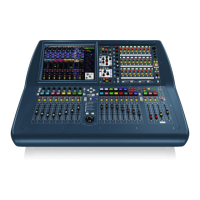Resilience to failure (redundancy) 15
PRO2 Live Audio System
Owner’s Manual
Resilience to failure (redundancy)
The PRO2 Control Centre has dual redundant power supplies, so if one fails the other
can carry on working. The N+1 principle is used for the audio, where the AES50 cables
include a redundant spare.
The GUI screen can be used to operate the control centre, even if no control surface
hardware is working.
Latency management
In the interests of reduced latency the primary channel types are restricted to three
time zones and the interconnecting buses are restricted to the time in between.
• First time zone: Input channels, including aux inputs that are set to input channel
mode. (Aux bus time is here.)
• Second time zone: Aux channels, including aux inputs that are set to effects
return mode. (Master and matrix bus time is here.)
• Third time zone: Master and matrix outputs.
Operating system
The PRO2’s operating system is Linux, which is an open-source, stable, proven
operating system (OS). Linux is used in many mission-critical applications worldwide
and has allowed Midas’ software engineers to write a ground-up system that contains
no ‘hidden’ or unused code. This has resulted in an efficient, compact application,
which is quick in operation, quick booting and comparatively easy to debug.
GUI
The PRO2 has a, daylight-viewable, TFT screen that provides overview and detail status
indication. The screen operated using a trackball and two buttons that, between them,
provide the same control as provided by a computer’s mouse.
The supplied USB keyboard lets you insert text into fields on the GUI screen.
Integration of third party hardware
The PRO2 network includes the capability to interface any third party hardware that
uses AES/EBU or AES50 digital audio, or a standard analogue audio interface.
Each PRO2 AES/EBU input and output has a sample rate converter. Synchronisation to
external AES3 interfaces can be:
• Global - via inputs on the routers.
•Local to each input.
• Local to each output (synchronisation to adjacent local output).
Multiple local connections can be at different sample rates.
The use of the AES50 protocol for the transmission of digital audio means that any third
party digital audio hardware that features this connection can be connected to the
Midas network, and will transfer audio to and from the Midas hardware without any
additional interfaces or converters (provided it runs in TDM 96kHz mode). This will be
particularly useful as the protocol gains acceptance with recording and playback
devices, loudspeaker controllers, audio networking systems, digital amplifiers etc.
The PRO2 Control Centre has a DVI connector on the rear panel, so that the control
centre view can be routed to an external monitor.

